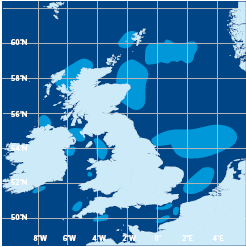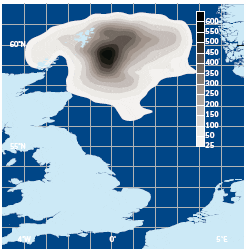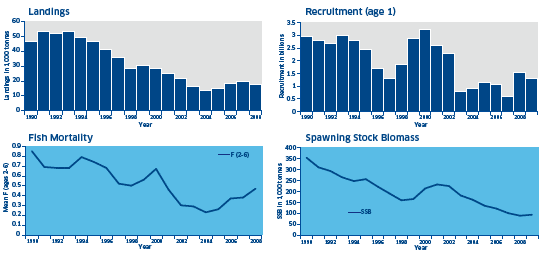Introduction

Recent estimates indicate that 50 per cent by weight, of the North Sea catch was landed for human consumption, 10 per cent for industrial processing and the remaining 40 per cent discarded. In terms of the total weight of demersal fish landed by the Scottish fleet whiting is ranked fourth. whiting is caught all year round throughout the North Sea as part of a mixed fishery, but is known to occur exclusively in some localised areas.
Biology
Whiting is one of the most numerous and widespread species found in the North Sea. high numbers of immature fish occur off the Scottish coast, in the German Bight and along the coast of the Netherlands. Tagging experiments, and the use of a number of fish parasites as markers, show that the whiting found to the north and south of the dogger Bank form two virtually separate populations. It is also likely that the whiting in the northern North Sea may contain populations including ‘inshore’ and ‘offshore’ groups.

At four years old, a single female fish of reasonable size produces more than 400,000 eggs. By two years old, however, most whiting are mature and able to spawn. The spawning season lasts from late January until June. The spawning season of an individual female lasts at least ten weeks, during which time she releases many batches of eggs.
Introduction
Like many other fish, whiting spend their first few months of life in the upper water layers before moving to the seabed. They grow very quickly for the first year, after which the growth rate becomes much slower. There are large differences between the growth rates of individual fish and a 30 cm fish can be as young as one year or as old as six. The whiting in the northern North Sea usually grow faster than their more southern counterparts.

Adult whiting feed mainly on juvenile fish and crustaceans (shrimps and crabs). The exact composition of the diet depends on the size of the fish, the area and the time of the year. In the North Sea, whiting is one of the main predators of other commercially important species of fish. Norway pout, sandeel, haddock, cod and even whiting themselves are frequently eaten. It has been estimated that each year the North Sea whiting population consumes several hundred thousand tonnes of these species.
ICES Advice on Management

Summary
- ICES advises reduction in TAC to stabilise SSB
- The state of the stock cannot be evaluated
- Modest increase in recruitment in 2007 year class
Precautionary approach reference points
The previously defined precautionary reference points (based on data from 1980 onwards) are no longer considered appropriate because of discrepancies between survey data and the catch data in the period before 1990.
State of stock
In the absence of defined reference points, the state of the stock cannot be evaluated. An analytical assessment estimates the spawning stock biomass in 2009 as being near the lowest level since the beginning of the time-series in 1990. Fishing mortality has declined from 2000-2004, but increased in recent years. Recruitment has been very low since 2002, with an indication of a modest improvement in the 2007 year class.
Management Advice
As no reference points are available, ICES advises on the basis of precautionary considerations that a significant reduction of the TAC is required to remedy the decline in SSB. An immediate TAC reduction of 61 per cent (13,400 t Total catch, 7,400 t human consumption catch) is needed to stabilise the stock, but rebuilding would require a further reduction.
Catches of whiting have been declining since 1980 (from 224,000 t in 1980 to 27,000 t in 2008, including discards and industrial bycatch). Distribution maps of survey IBTS* indices show a change in distribution of the stock which is now located mainly in the northwestern North Sea. Catch rates from localised fleets may not represent trends in the overall North Sea and English Channel population. The localised distribution of the population is known to be resulting in substantial differences in the quota uptake rate. This is likely to result in localised discarding problems that should be monitored carefully.
The basis of the a advice has changed from last years, which set a maximum fishing mortality rate (Fmax). This years’ advice is aimed at stabilising the SSB.
Management action
At the december 2009 meeting in Brussels, the Council of Ministers decided that the EU Total Allowable Catch for North Sea (Iv and IIa) whiting should be 11,044 tonnes. The uk quota for 2010 was set at 7,391 tonnes.
May 2010

